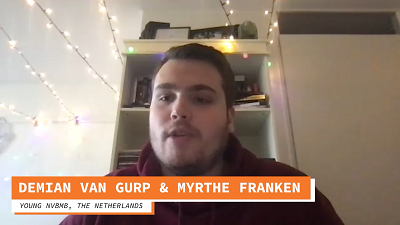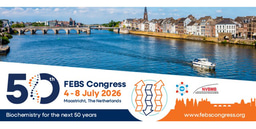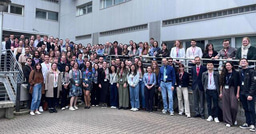Young NVBMB – An overview


When was Young NVBMB established?
NVBMB noticed the average age of their membership was getting older, so they decided to contact student associations in the Netherlands that are focused on biochemistry, molecular biology, biotechnology, or the life or natural sciences more broadly. These study associations, which are based around a university city, are important in the Netherlands and have at least 500 members each, so they are a good way to contact students. The associations are also eager to collaborate because they want to provide as many events and activities as possible, especially when they do not have to do much to organize the events.
NVBMB asked those associations if they wanted to organize joint lunch lectures to make NVBMB better known among the students. In 2020 and 2021 NVBMB organized several online lunch lectures in collaboration with these study associations.
NVBMB were keen to continue with the collaboration this year but also wanted to make sure that they did not have to explain how everything works to the students every year. To achieve both aims, they looked for students who wanted to supervise and professionalize this collaboration between the study associations and NVBMB, as well as get NVBMB even better known among the younger generations. Myrthe and Demian, who were Board members for some of these study associations, agreed to do it and set off to supervise and reshape the structure of the Young NVBMB, to provide a space at NVBMB for the younger generation, such as Bachelor and Master students, as well as PhD students.
Five study associations are currently collaborating with the Young NVBMB (GLV Idun, SV Mens, ULSV Amino, CODON, and SvBMT Protagoras) but there could easily be up to 50 relevant associations that could still be contacted, as each University has more than 200 study associations in different disciplines. Young NVBMB hope to link up to more associations soon, as their initiative becomes more established.
How many members do you have?
Young NVBMB is a service within NVBMB and they do not currently have their own members. What they do is offer the younger generation of NVBMB activities relevant to them, and a platform where they feel connected to other students and researchers throughout the Netherlands, not just in their own city. NVBMB has approximately 300 members born after 1994.
Do you have a specific structure?
The current structure of Young NVBMB is mostly an informal educational bridge between the five study associations that are part of the initiative. A group of students from the city study associations organize lunch and drink lectures, with Young NVBMB acting as an umbrella association supervising this group. They are also responsible for ensuring all the city associations are equally involved in the organization of the lectures, as well as ensure that all students that do biochemistry or molecular biology as part of their course are welcome and know who Young NVBMB are. Some of the NVBMB Board members oversee and help with the organization of the lunch lectures.
What activities do you do?
Currently Young NVBMB organizes lunch lectures and drink lectures on topics related to the NVBMB. They want to organize more activities besides these lectures, but that will be in the future, when the Young NVBMB has been more established.
Young NVBMB also provide information on what type of grants younger researchers can apply for. NVBMB normally provides this information, but the Young NVBMB have added extra information and explanations focused on students and younger researchers. They also want to ensure information such as about the FEBS Congress reaches the students, so they can find out about different research areas of molecular life sciences. In the Netherlands, Bachelor and Master students already do some research, so they would be interested in what research options are available to them, especially as they need to know before the end of their studies what area they want to go into.
How does you fit into NVBMB?
Young NVBMB and NVBMB collaborate in organizing activities for students. Some Board members of NVBMB also occasionally attend the meetings of the study associations, to discuss together how they can improve the initiative and their activities. NVBMB and Young NVBMB are developing their communication channels, to accommodate everybody’s busy schedules.
Young NVBMB use the network of contacts of NVBMB to get in touch with and promote interesting researchers and those with grants from NVBMB. This is a way to inform the younger generation about the different research groups working in the Netherlands, and about the grants available to them.
Young NVBMB recently wrote a policies document explaining how they would like to shape Young NVBMB within NVBMB. This document addresses many issues and processes, from a schedule of talks and other activities to the communication plan with the study associations and the NVBMB. They want to position themselves so they can provide a service for the younger generation of biochemists and molecular biologists and to invite them to create a broader network in this field, to improve connections and access to information.
They are also considering how to keep in touch with the students as they go on to do a PhD or other careers in the life sciences by, for example, getting PhD students to join the Young NVBMB group. However, Young NVBMB want to establish their Bachelor and Master student network first before they go on to develop a young researchers network. Their aim is to explore this in 2022, once they have become more professionalized, have created a social media presence, and have made initial contacts with existing PhD networks in the Netherlands to try to involve them too.
NVBMB is also supporting this by contacting different research groups and asking them if someone at the group will get in touch with the Young NVBMB, as well as promote the Young NVBMB on the magazine of the parent organization, the Royal Netherlands Chemical Society (KNCV).
Do you have a budget?
Young NVBMB is a part of NVBMB and they do not have their own budget, but they can ask for funding from the NVBMB if there are cost associated with the activities, promotional material, etc. However, none of the expenses are specifically labelled as Young NVBMB and all costs need to be reasonable and relevant.
How do you recruit more members?
Currently Young NVBMB does not recruit its own members so instead they try to recruit new members for NVBMB from those that participate in events and activities organized by Young NVBMB. Young NVBMB promote the activities to all the students in the study associations, which helps promote Young NVBMB.
Recruiting young members was difficult for NVBMB, even when they got in contact with the study associations. In the past NVBMB offered discounted membership to students, by giving them the first year free, as well as a small amount of funding to the study associations for each of their members that also joined NVBMB. Unfortunately, after the free first year and once the extra funding to the study associations stopped, the students cancelled their membership with NVBMB, partly also because it was not clear to some of them what the membership offered. Now NVBMB is trying to maintain young members by providing activities for them and Young NVBMB is trying to make it clearer to all the students what benefits they can have by joining.
Another objective of the Young NVBMB goals is to improve the NVBMB website and make it easier for students to contact Young NVBMB, and get information and ask question about NVBMB, such as what they do, what activities there are for students, and what funds are available for students. They also want to develop a stylized identity that represents Young NVBMB and visual resources, such as flyers and posters, that can be shared with the study associations. They also want to start social media accounts, which make it easier for the younger generation to be up to date, as many students do not look at websites anymore and look at platforms such as Instagram and LinkedIn instead.
What do you think motivates students and young researchers to volunteer for Young NVBMB?
A big motivator are the contacts you can make in the life science community not only in your city but all around the Netherlands, and even all over Europe. Students in the Netherlands already have access to a network through their city study associations but being part of wider networks, such as that provided by Young NVBMB, or by the FEBS Junior Section, can bring additional benefits. One main benefit is making connections with other students and researchers. Bachelor and Master level students are expected to organize internships during their course and, by having access to a wider network that their city study association, students will have access to more opportunities. In each city the study associations organize an ‘internship market’ for the students, and if Young NVBMB could be present and offer national or even wider opportunities at those events, it would help promote Young NVBMB. It is also a lot of work for students to find out where you can go for your internship, so if NVBMB already has information and contacts throughout the country, it would be helpful for students to access that information. Young NVBMB also want to show how the community can help, by providing information on grants available, linking to people to discuss topics with, and connecting with peers to talk about professional development, such as connecting to PhD students who can advise on the best way to obtain an internship.
Likewise, the FEBS Junior Section could help identify places to go all over Europe, access Europe-wide resources, and maybe organize symposia and other educational activities for students to discover key research areas and make contacts. Young NVBMB want to clarify and consolidate these benefits, to be able to encourage students to join those larger networks.
In addition to making contacts, being able to actively participate in Young NVBMB and its activities is also a good motivator, and the organizers are working hard to ensure that can happen as their group gets bigger. They think that if the structure or Young NVBMB is organized well so that there is not a lot of extra work to do for the students, and the initiative’s aims and activities are clear so they can be communicated easily, there will be more students interested and motivated to join and help.
There are additional ways to motivate students. For example, in the Netherlands if you help with the running of the Board of an organization you often get financially compensated, and some financial support would motivate many students, as studying is expensive. Gaining a group of friends can also be motivating, as collaborating can lead to friendships, sometimes in different cities and countries. Highlighting this can show that volunteering is not only about organizing events and activities, and can have social benefits too. It also looks good on student’s CV to get involved in this type of initiative. Finally, there are many students who are just keen to get involved, help, and do new activities, and it can be useful to tap into those motivations to recruit new members.
What are Young NVBMB aims for the FEBS Junior Section?
To get in touch, share practices and enjoy events and activities together with other students and young researchers in Europe, be it in person or online. Together we will strengthen our networks!
We also want to say that a new junior section does not need to be an independent initiative if it can rely on the national Society for help, guidance and funding. It also does not need to follow such strict lines as a main organization. Try to start small, maybe as a part of an existing section or group and, within that, develop and evolve into a working platform where students and young researchers can meet, share, and enjoy being part of the biochemistry and molecular biology disciplines and everything that is related to the field.
Creating a new Junior Section?
If you are interested in creating a new Junior Section in your Society, or consolidate an existing one, we encourage you to read the posts and watch the videos from the other Junior Sections (Junior-GBM, ÖGMBT’s Young Life Scientists Austria (YLSA), SIB Sezione Giovani, HDBMB Young Scientists’ Forum, SEBBM Junior Consuls, and the Biochemical Society’s Early Career Advisory Panel). And if your Society already has a Junior Section, please get in touch!
Help us spread the word about the FEBS Junior Section initiative by sharing our post on Junior Sections and overview video in your country and research community. Thank you!





Join the FEBS Network today
Joining the FEBS Network’s molecular life sciences community enables you to access special content on the site, present your profile, 'follow' contributors, 'comment' on and 'like' content, post your own content, and set up a tailored email digest for updates.